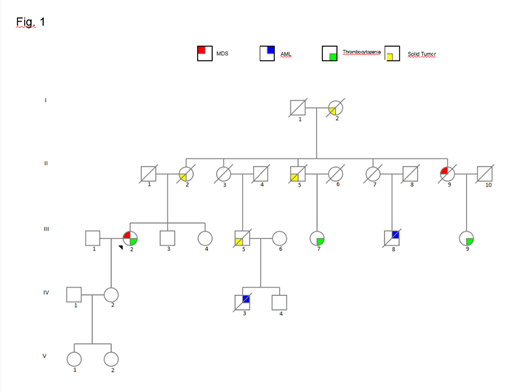Abstract
Introduction
In AML and MDS cases, the genetic lesions inherited or acquired by the hematopoietic stem cells are considered as starting events. Familial AML and MDS, recently recognized in the revised WHO classification (2016) provide a useful model for investigation of predisposing genetic mutations. Genetic analysis of several pure familial leukemia pedigrees led to the discovery of well defined syndromes associated with inherited de novo mutations on germline DNA. Growing clinical awareness as well as a widespread use of NGS have led to an enlarged description of familial MDS/AML cases, and the number of mutations involved, suggesting they are more frequent than those previously recognized. Despite the recent discovery of well-established causative gene mutations (RUNX1, GATA2, ETV6, TERT, TERC, SRP72, ANKRD26, DDX41, CEBPA), many cases remain unexplained (about 80%), suggesting that other inherited mutations could predispose to MDS/AML. It is expected that new sequencing approaches will help to the identification of more cases, more genes as well as novel syndromes.
In 2017, we started a multicentric prospective study (Clinical trial.gov NCT03058588) aiming to look for predisposing mutations in patients and relatives affected by Familial AML and MDS syndromes (FAMS) by NGS and to screen for old and new mutations potentially associated with the disease.
Methods
At present, 12 AML/MDS patients have been enrolled. Leukemic (bone marrow) and germline (buccal swab) DNA were analyzed by NGS gene panel approach based on a 28 genes associated to myeloid leukemogenesis, including the 9 above mentioned genes associated to FAMS. NGS libraries were performed by a Nimblegen (Roche) custom panel based on gene capture strategy and the sequencing was performed by MiSeq (Illumina).
Results
Ten patients did not reveal any germline mutations and the candidates are undergoing to whole exome sequencing. One presented a germline mutation on RUNX1, and the analysis of the affected relatives is on going. One revealed a new mutation. She was a 70 years old woman affected by RARS and her pedigree was characterized by 9 relatives affected by hematologic and solid neoplasia and trombocytopenia (fig 1).
The NGS analysis revealed the mutation c.*514C>T in 3'UTR of ETV6 with VAF of 50% on tumor DNA. The variant has never been described before, while ETV6 has been already associated with FAMS. Sanger sequencing confirmed the mutation on the germline DNA in heterozygosis. The screening of 2 affected relatives still alive confirmed the presence of the variant in heterozygosis. In silico analysis performed on PolymiRST Database revealed that c.*514C>T in 3'UTR of ETV6 results in a gain of miRNA binding site: hsa-miR- 4717-3p and hsa-miR- 942-3p.
Discussion
The variant c.*514C>T in 3'UTR of ETV6 seems to repress ETV6 due to RNA interference. The new binding miRNAs have been already described as over-expressed in solid and hematologic tumors. Moreover, the down-regulation of ETV6 is associated with alteration of cell growth and hematopoiesis. Due to these evidences, c.*514C>T in 3'UTR of ETV6 could be considered as a new mutation involved in FAMS predisposition.
No relevant conflicts of interest to declare.
Author notes
Asterisk with author names denotes non-ASH members.


This feature is available to Subscribers Only
Sign In or Create an Account Close Modal